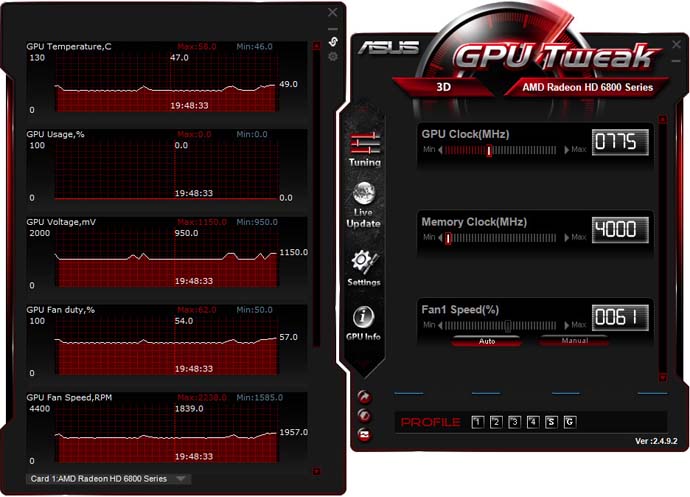

- #Asus gpu tweak 2 guide install#
- #Asus gpu tweak 2 guide manual#
- #Asus gpu tweak 2 guide software#
- #Asus gpu tweak 2 guide download#
However, if your CPU is at 100 percent, that means it is the weak link and that your GPU is sitting idle, waiting for the CPU to finish its job. Depending on how optimized a game is, CPU utilization will range from 40 to 80 percent for most gaming rigs. These parameters are extremely important.
#Asus gpu tweak 2 guide software#
The option labelled CPU temperature is reported from software and isn't quite accurate.

This is the accurate temperature reported directly from the CPU die. Be sure to use the CPU1 temperature-monitoring option. Thermal throttling is what we are looking for here. However, processor clock speeds aren't as temperature-dependent as that of GPUs. The same reasons apply to CPU temperatures as well. The Temperature Limit parameter is also a great means to know if your GPU performance is hit hard on account of thermal throttling.Īlso read: What is VSync, and Should I Turn It On or Off? CPU Temperature Case in point: both Pascal and Turing Nvidia GPUs provide loads of extra boost clock speeds with every five-degree drop in temperature. Getting the most out of your GPU is no longer restricted to prevent thermal throttling, but to ensure that the GPU runs as cool as possible.
#Asus gpu tweak 2 guide manual#
Modern GPUs tend to take manual overclocking control away from users and instead base it on thermal headroom. Monitoring the Fan Speed to verify proper operation along with using aggressive fan profiles should also help. An overheating GPU is a sign that remedial measures such as GPU heatsink cleaning and thermal paste reapplication is required. Keeping an eye on GPU temperature relative to the ambient temperature gives a good idea of the overall health of the cooling system of your graphics card. The following lays out the parameters you should take note of. That involves keeping an eye on numerous statistics involving thermal, utilization, power, voltage, and clock speeds for the CPU, GPU, and memory subsystems. RTSS comes with a long list of features and capabilities, but we are primarily interested in the capability to monitor hardware parameters to improve the gaming experience. There's a lot here, so have a play around and do some customizing! Using RTSS to Monitor Hardware Performance Other games, meanwhile, will require the "Custom Direct3D support" option to be enabled. A good option for games, for example, is to enable Stealth mode, which will prevent it from interfering with anti-cheat software in online games. With Hades selected, I can now change the different RTSS settings specific to that game. I, for example, added the game Hades here. One of the more interesting features here is that if you click Add at the bottom-left corner, you can add RTSS profiles for specific programs and apps. The tab contains a list of hardware parameters relevant to the CPU and GPU. Navigate to the Monitoring tab in the Settings window. Alternatively, you can leave everything unchanged at the default settings and head straight to configuring RTSS by clicking on the Settings button represented by the gear icon.Ĥ. Open MSI Afterburner and dial in the overclock settings for the GPU.

It's not possible to monitor critical hardware parameters without RTSS.ģ.
#Asus gpu tweak 2 guide install#
Install the tool and be sure to select RivaTuner Statistics Server when you are prompted to choose components during the installation.
#Asus gpu tweak 2 guide download#
Download the latest stable release of MSI Afterburner bundled with RTSS.Ģ. Here's what you need to do to get started.Īlso read: Do You Need A 360 Hz Monitor? Ultra-High Refresh Rates Explained Install and Configure RTSSġ. This guide is based around MSI Afterburner, which comes bundled with RTSS. RivaTuner itself has since been assimilated into virtually all major GPU overclocking tools, such as MSI Afterburner, EVGA Precision X, and ASUS GPU Tweak.


 0 kommentar(er)
0 kommentar(er)
